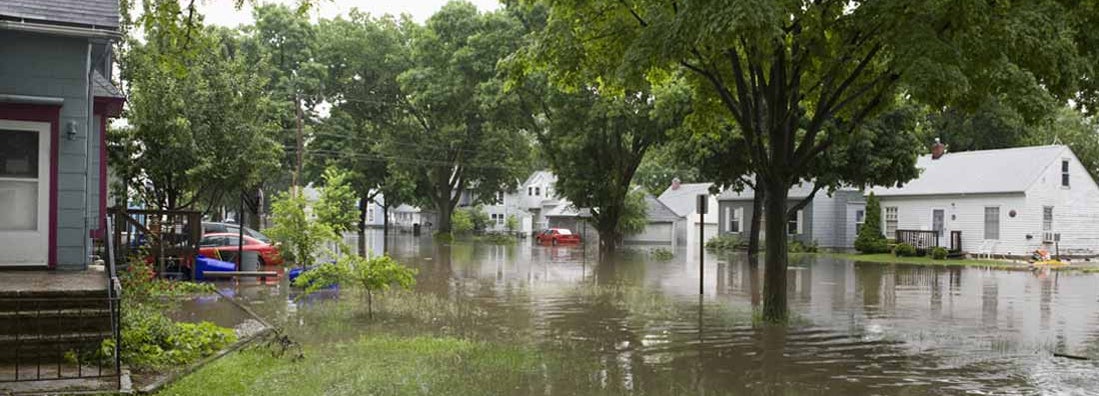What to Do After Your House Floods
A guide of steps to take after your house floods and tips for future flood disaster preparedness.

Floods can cause devastation in numerous ways. They can damage or destroy homes and personal property, lead to injuries and death, and cause quite a bit of financial strain. However, filing flood insurance claims doesn't have to be stressful if you're familiar with the process. You can follow some simple tips to get your home and life back on track after a flood.
An independent insurance agent can help you get equipped with all the flood insurance you need if you're not already covered. This guide can also help you resume normal life ASAP after a flooding disaster strikes. Here are some simple steps to take after your home floods and tips for preparing for future disasters.
What to Do After Your Home Floods
So, your home flooded. Now what? The first step, really, is to stay calm. From a more grounded place, you'll be more easily able to follow the necessary steps to help get your affairs back in order and life back on track. Start by taking these steps after your home floods.
Step 1: Make Important Calls
- Contact your family: If you have any family members out of town, out of state, or just out of the loop in regard to your status after a flood, give them a call and let them know you're safe.
- Contact your independent insurance agent: Your independent insurance agent can help get the process of filing flood insurance claims started for you after a flood damages your home and/or personal property. You'll need to tell them about the incident and exactly what happened to your home.
- Call FEMA: Give FEMA a call and report your situation, and take advantage of any free resources they offer.
Step 2: Document the Damage
- Document your home's structural damage: Do a walkthrough of your home and around its exterior, getting all damage on video if you can.
- Document your personal property damage: Also, get documentation of damage to your personal property, like furniture, either via video or photos.
- Keep copies of all records for yourself: Make and keep copies of everything you send to your insurance company and store them safely. Keep copies of all photo and video evidence, paperwork submitted for the claims process, and written documentation of the dates and times of your conversations with your carrier or independent insurance agent.
Step 3: File Insurance Claims
- Submit paperwork within 60 days: After the flood, most insurance companies will give you 60 days to sign and submit a Proof of Loss form.
- Request additional compensation if necessary: If home repairs will be more expensive than the adjuster originally determined, you can request additional compensation from your carrier.
- Report any additional damage: If you find more damage to your home than originally discovered when you filed your claim, contact your independent insurance agent or carrier again and let them know ASAP.
- Stay connected: Your independent insurance agent can keep you updated through every step of the claims process and even provide you with ETAs on when you can expect to receive compensation.
Step 4: Schedule a Visit from an Adjuster
- Schedule the visit: You'll need to work with your insurance company to schedule a visit from an adjuster who can assess the damage to your home and property in person.
- Be prepared with all required documents: Be ready to provide your insurance adjuster with evidence of your damaged property and have your insurance information, including your policy number, on hand for them.
- Wait to start repairs: Get your insurance adjuster's contact information and hold off on starting any required repairs until they give you the okay to do so.
Tips for Reentering Your Home After a Flood
After a flood, don't just return to your home immediately. Floodwaters can present new dangers that weren't there before, even after the initial mess has cleared. Follow these tips for reapproaching your home after a flood disaster.
- Don't enter until it's declared safe: Wait for an official inspector to declare your property safe for reentry after a flood.
- Get protective gear: Get equipped with gloves, rubber boots, and overall protective clothing to keep you safe from the dirt and grime flooding can leave behind. Wearing an N95 mask or a respirator can help protect your lungs from inhaling mold spores and other pollutants.
- Disconnect all systems: Turn off your home's utilities immediately, including power, gas, and water before you reenter the home. Contact professionals like an electrician, plumber, etc., if you're concerned your home's systems may have been compromised.
- Be on the lookout for pests: Floodwaters can be filled with pests like snakes, and these critters can stay behind even after the water has moved on or dried up. Be cautious as you reenter your home, as pests may be lurking.
- Remove all soiled property: Anything that was in your home that got wet due to the flood must be removed and cleaned or tossed right away. Remove any soiled carpeting. Furniture and mementos can be cleaned and saved, but it's best to toss everything else that's not an absolute necessity to keep.
- Do a deep clean: You'll need a shop vac and a hose to clean your home thoroughly. The hose can help flush bacteria from wet or previously wet surfaces. After using a shop vac to remove all remaining water, get a strong disinfectant for any surfaces that were touched by floodwaters. Use a mixture of a gallon of water and a half cup of bleach to kill any remaining bacteria and mold. Just don't use the solution on anything that's metal.
- Let it dry: Use large fans to dry the home and your property once it's all been through a deep clean. Leave doors and windows open to help ventilate and let fresh air come through. It may take up to two to four weeks for everything to completely dry after a flooding incident.
- Hire licensed contractors: If you're ready to rebuild and repair your home, take your time with the search for a properly licensed contractor. Always request proof of contractor insurance before signing any contracts. Be wary of anyone who asks you to pay a huge deposit before they begin work, and be aware of other common contractor scams. Check their references for extra validation.
Preparing for Future Floods
After successfully handling one flood, you'll be better equipped to handle another disaster in the future. Hopefully, you won't have to endure more than one flood in your home, but if you do, you can take a couple of simple steps to ensure the recovery process goes even more smoothly.
Prepare an emergency kit that contains non-perishable food, bottled water, and other necessary supplies like batteries, a radio, etc., and keep it in an easy-to-grab location in your home at all times. Research how to flood-proof your home and take those necessary actions before the next rainy season starts.
And finally, ensure you're set up with all the flood insurance you need since homeowners insurance won't cover flood claims if the source of the water was rainfall, melted snow, etc. Your independent insurance agent can help you get covered fast.
Why Work with an Independent Insurance Agent?
When a flooding disaster occurs, the last thing you want to have to deal with is not having the right insurance coverage to give you the reimbursement you deserve. Working together with a local independent insurance agent can help you get equipped with the right kind and amount of flood insurance to protect your home and personal property against flooding disasters.
These agents shop and compare policies from multiple carriers for you, ultimately finding you the best blend of coverage and cost. And if a flood occurs, they'll be there to help you file claims and keep you updated with the claims process.
https://www.progressive.com/lifelanes/household/home-flooding-cleanup/
https://www.ramseysolutions.com/insurance/recovering-from-flood
